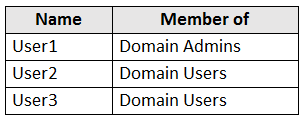

HOTSPOT -
Your network contains an Active Directory domain named adatum.com. The domain contains two computers named Computer1 and Computer2 that run Windows
10.
The domain contains the user accounts shown in the following table.
Computer2 contains the local groups shown in the following table.
The relevant user rights assignments for Computer2 are shown in the following table.
For each of the following statements, select Yes if the statement is true. Otherwise, select No.
NOTE: Each correct selection is worth one point.
Hot Area:

Anthony_2770
Highly Voted 4 years, 6 months agoAnoniMouse
Highly Voted 3 years, 12 months agovanr2000
3 years, 9 months agomikl
3 years, 5 months agoAmir1909
Most Recent 1 year, 4 months agoraduM
2 years, 11 months agoBAbdalla
3 years, 8 months agoJunhhhch
3 years, 11 months agoJunhhhch
3 years, 11 months ago